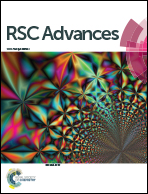One-pot synthesis of multidimensional conducting polymer nanotubes for superior performance field-effect transistor-type carcinoembryonic antigen biosensors
Abstract
Carcinoembryonic antigen (CEA), a glycoprotein, is a crucially important tumor marker due to its relation to carcinomas. An abnormal level of CEA in the serum is connected to a diagnosis of cancer. In this work, highly sensitive and selective field-effect transistor (FET) biosensors were fabricated to detect CEA, using aptamer-functionalized multidimensional conducting-polymer (3-carboxylate polypyrrole) nanotubes (Apt–C-PPy MNTs). The multidimensional system, C-PPy MNTs, is firstly produced by a solution based temperature controlled self-degradation method. The C-PPy MNTs are integrated with the CEA-binding aptamer immobilized on an interdigitated array electrode substrate by covalent bonding with amide groups (–CONH) to produce a FET-type biosensor transducer. The resulting C-PPy MNT-based FET sensors exhibit a rapid response in real time (<1 s) and ultrasensitivity toward CEA with a limit of detection of 1 fg mL−1. This limit of detection is 2–3 orders of magnitude more sensitive than previous reports. The liquid-gated FET-type sensor showed specificity toward CEA in a mixed solution containing compounds found in similar proteins and biological signals. Additionally, a superior lifetime is demonstrated for the FET sensor, owing to the covalent bonding involved in the immobilization processes.


 Please wait while we load your content...
Please wait while we load your content...